Response to Kent Hovind Video - Bird Evolution
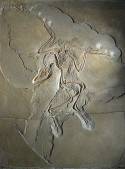 Not too long ago, I watched a Kent Hovind video on creationism. I mentioned it in a previous entry, Creationist Dishonesty and a Follow Up to Previous Entries, where I discussed a blog I'd visited previously that had plagiarized this information from Hovind. This time around, I'm going to address the actual claims Hovind made. Specifically, I'm going to address birds evolving from dinosaurs and archaeopteryx, since that's a topic that interests me.
Not too long ago, I watched a Kent Hovind video on creationism. I mentioned it in a previous entry, Creationist Dishonesty and a Follow Up to Previous Entries, where I discussed a blog I'd visited previously that had plagiarized this information from Hovind. This time around, I'm going to address the actual claims Hovind made. Specifically, I'm going to address birds evolving from dinosaurs and archaeopteryx, since that's a topic that interests me.
I think I've found a copy of the lecture that I watched. It's a little difficult to be certain because Hovind has delivered this lecture numerous times, and several of these were recorded and put online. But I'm reasonably sure that this is the correct one. It does seem, however, that the version I watched on TV was edited a bit to trim out a few comments, presumably to better fit the half hour time slot. But all versions of the lecture I've seen are very similar, so the response below is relevant to all of them.
The lecture is part of Hovind's Creation Science Seminar. The show I watched on TV was a half hour segment pulled from Part 4 of that seminar, Lies in the Textbooks that Support Evolution. The segment on bird evolution that I'm going to address in this entry begins right around 2:30:00 in the video below.
For this entry, I've put what Hovind said in blockquotes below, followed by my responses to his claims. The transcription of Hovind was done by me, and although I tried to be careful, I apologize if there are any mistakes or typos.
They say dinosaurs turned into birds. There are very few ideas as dumb as this one. The Bible says God made the birds on day five. He made the reptiles on day 6. Evolution says reptiles came first, and then the birds. You know, everything about evolution is backwards to the Bible. Everything.
Well, I do have to agree with part of this. The order of creation in the first chapter of Genesis is counter to the actual history of life on this planet. I mentioned that previously in my essay, Problems with a Day-Age Interpretation of Genesis (too comment, see the blog version). But then again, the order of creation in the first chapter of Genesis is also counter to that from the second chapter of Genesis, where man came first, followed by the garden of Eden, followed by "every animal of the field and every bird of the air", followed finally by Eve. I realize that some Christians interpret these stories allegorically or metaphorically or in some other way, but having two differing creation stories back to back shows that they can't be literally true.
But this article says, 'Dinosaurs alive as birds, scientist says'. Ooo wow, scientist says. Well that proves it right there. Just like it gives some kind of authority. Ooo, wow, scientist says. This is absurd. Everything about the bird evolution is baloney. Okay.
Nothing of substance to comment on here.
Archaeoraptor was listed in 1999 as the missing link. Yes, boys and girls. Breaking news! National Geographic. We found the missing link. They had a whole big article about the missing link has been discovered. Then a couple months later, oops, it was proven wrong.You know, everything about these feathered dinosaurs has been proven baloney. But guess what. They're still teaching it. Here's a whole book, the Feathered Dinosaurs of China. [pointing] You just got this recently? Why would they still be teaching something that's been proven wrong for five years? All this feathered dinosaur stuff is baloney. It's all baloney.
First things first, yes there are plenty of examples of feathered dinosaurs. Wikipedia has a rather good entry on Feathered dinosaurs, listing 34 specimens of non-avian dinosaurs with preserved evidence of feathers (that is, 34 as of the time I right this - I suspect that number will grow as new fossils are unearthed). There's no excuse for Hovind to claim that feathered dinosaurs haven't been discovered.
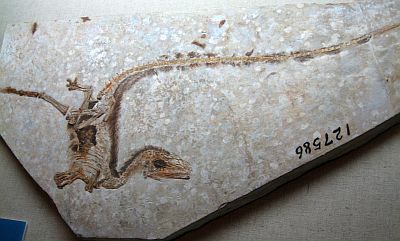
Sinosauropteryx
(Source: Wikipedia)
Now, the story of Archaeoraptor does point out legitimate problems with science journalism and the fossil trade, but it was an isolated incident, was never the sole piece of evidence for feathered dinosaurs, and actually highlights the benefits of the standard scientific practice of peer review. A fairly complete story of this incident is available on Wikipedia. A farmer found several fossils in his field, and combined them to create what looked like a complete animal. He sold the fossil to a dealer who smuggled it into the U.S. Then, National Geographic funded research on the specimen, and although some scientists began noticing problems right away, the lead researcher refused to acknowledge them. Both Nature and Science, the two most prestigious science journals, rejected papers about the specimen, with some of the reviewers for Science even noting that it had been doctored. But National Geographic never heard about any of these problems because the lead researcher never told them (and they obviously weren't practicing enough oversight), so they ran with their article, publishing it in the November 1999 issue of their magazine, with a corresponding press conference in October. National Geographic received further feedback from the scientific community, and released a press release in February of 2000 noting that the specimen might have been a composite, and then fully admitted the mistake in their October 2000 issue.
This was an example of the dubious practice of 'science by press release', bypassing the normal peer review process and jumping right to public promotion. Most of the scientists associated with the archaeoraptor specimen realized there was something fishy about it, and had it not been for the hype generated by National Geographic, the regular peer review process would done its job and 'archaeoraptor' would have died a quiet death. As it was, the fossil only made a splash in the media, and was never taken seriously by the majority of the scientific community. It's also an example of why it's so important for paleontologists to have access to the sites where the fossils are found, and why the black market fossil trade is so damaging. No paleontologist would have come across all of those separate fossils and assumed them to have come from the same animal.
But an important point of this story relative to Hovind's claims is that the doctored archaeoraptor specimen was still made up of real fossils. In fact, one of the fossils was the counter slab to a nearly complete specimen of Microraptor zhaoianus, which is a feathered dinosaur.
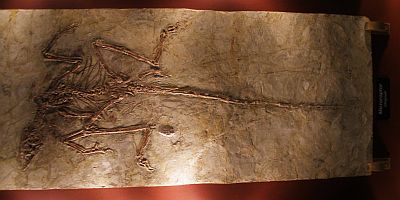
Microraptor zhaoianus
(Source: Wikipedia)
We cover more on that in one of the debates I did. I forget which one, but, uh, they say 'birds are descendants of dinosaurs'. Well, kids, in case you don't know, there are a few differences between a dinosaur and a bird. Okay. You don't just put a few feathers on 'em and say, 'Come on man, give it a try. It won't hurt too bad.'It's just not that easy. See, reptiles have four perfectly good legs. Birds have two legs and two wings. So, if his front legs are gonna change to wings, ah, somewhere along the line they're gonna be half leg and half wing, which means on that particular day, he can't run anymore, and he still can't fly yet, so he's got a real problem. A serious problem.
Just for reference, here's the image Hovind showed while talking about putting feathers on dinosaurs.

Kent Hovind's Idea of Dinosaur Evolution
(Source: YouTube)
This argument is just so silly it almost doesn't even deserve a response. Nobody is proposing that birds evolved from sauropods. Birds evolved from theropods, most probably maniraptorans or something closely related. Here's a picture of my favorite non-avian dinosaur, a deinonychus. It's a dromeosaurid, one of those groups closely related to the maniraptorans.
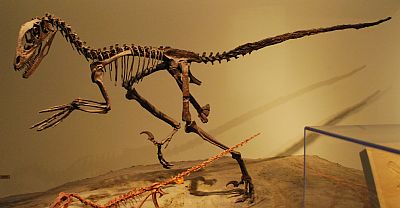
Deinonychus
(Source: Wikipedia)
I think it's pretty obvious from that picture that a deinonychus could run pretty well using just its hind legs, freeing up its arms for other purposes. Why would anybody suggest that early birds would have needed their front limbs for running?
They say archaeopteryx is proof of - for evolution. Whenever you buy a bag of dinosaurs, they almost always stick one of these in there. Archaeopteryx. Wow. And this somehow gets the impression to the kids, 'Wow, we got proof that dinosaurs turned to birds. Here's one with feathers on it.'
Okay, so now we're finally getting to archaeopteryx. I think I'll use this as an opportunity to provide a link to an older entry of mine, Book Review - Archaeopteryx: The Icon of Evolution. That entry is a review of the excellent book by Peter Wellnhofer, and I'll be referring back to it a few times in the remainder of this entry. I'll also mention another previous entry, Book Review - Evolution: What the Fossils Say and Why It Matters, reviewing the book by Donald Prothero. There's an excellent illustration from the book that I included in that blog entry comparing anatomical features of birds, archaeopteryx, and a few non-avian theropods.
They're lying. It's still in the textbooks, I mean today, about archaeopteryx. And it's been proven years ago archaeopteryx was just a bird, a perching bird. Alan Feduccia, who believes in evolution, says it's not a missing link. It had the right features for flight. All the features of the brain were for flight. Okay.
Regarding archaeopteryx's 'features for flight', I'll quote myself from my review of Wellnhofer's book, "One of the things that struck me is just how much more dinosaur-like than bird-like archaeopteryx was (yeah, yeah, I know - birds are dinosaurs, but I think my meaning is clear enough). In fact, the Solnhofen Specimen was originally mistaken for a Compsognathus theropod by an amateur collector. I've included two pictures from the book below to dramatically illustrate this (I apologize for the quality of the scans, but like I said in another review, I wasn't about to ruin the binding on my book just to make it lay flat in the scanner)."

Comparison of Bambiraptor, Archaeopteryx, and a Modern Chicken - not to scale
(Source: Archaeopteryx: The Icon of Evolution)

Comparison of Archaeopteryx to a Modern Eagle - not to scale
(Source: Archaeopteryx: The Icon of Evolution)
"Take a close look at those skeletons. If you had to pick which other animal archaeopteryx was most closely related to, it seems pretty obvious that it would be the bambiraptor. Archaeopteryx still had clawed hands, a hyperextensible 'killer' claw on its foot (though not shown in the above reconstruction), a long boney tail, gastralia (the bones under the stomach), a more theropod pubis, and teeth in its mouth. Just as important is what archaeopteryx didn't have - a pygostyle, a keratinous beak, a large keeled sternum, fused hand bones, a fused tibiotarsus, or a fused tarsometatarsus. It also seems pretty likely that archaeopteryx lacked a bastard wing. And those are just some of the differences between archaeopteryx and modern birds."
In fact, the last time I was at the Perot Museum of Nature and Science and looking at the fossils and casts there, the thing that struck me was just how big the keel is on the sternum of modern birds to anchor all those flight muscles, and how inadequate archaeopteryx looked by comparison. In fact, while the consensus seems to be that archaeopteryx could most likely fly, it probably wasn't a very strong flyer.
I also have to point out the error in thinking that archaeopteryx perched. The consensus is that archaeopteryx didn't have a rear facing toe, and so couldn't perch. In fact, it doesn't appear to have been arboreal at all, but rather a fully terrestrial animal.
And one more note to keep in mind in these discussions - archaeopteryx may not even have been a bird, depending on what the definition of 'bird' turns out to be, and pending more fossils to fill in the details of early bird evolution. It was definitely closely related, but it may have evolved flight or gliding independently from the lineage that led to modern birds.
Archaeopteryx means 'ancient wing', and he had claws on his wings. Well, that's kind of unusual, okay, but twelve birds today have claws on their wings. The swan, the ibis, the hoatzin. Well, several birds have claws.
The commonality in the hands of archaeopteryx and non-avian dinosaurs is not just in having claws. After all, as Hovind correctly points out (you won't hear that phrase too often), many living birds have claws (pay close attention next time you're eating chicken wings). The commonality is in the size & structure of the claws, but more importantly, in the overall structure of the hands.
Take a look at the images below. The first is an ostrich wing, with the claws clearly visible. The latter two are an archaeopteryx and a deinonychus. If, as Hovind claims, an archaeopteryx is clearly a bird, see if you can figure out which one of the latter pair is the archaeopteryx, and which is the deinonychus.
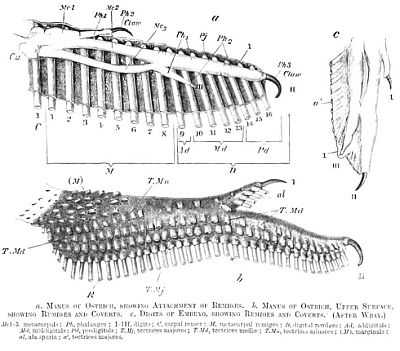
Ostrich Wing
(Source: Tetrapod Zoology)
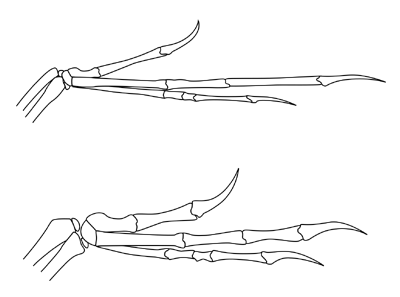
Archaeopteryx & Deinonychus Arms
(Source: Wikipedia)
It's not so easy, is it? You might have noticed that the hand on the top is more gracile and correctly surmised that it was the archaeopteryx, but it's obvious just how much more similar that archaeopteryx and deinonychus are two each other than either is to the ostrich. The ostrich bones are fused, while the archaeopteryx and deinonychus bones are all distinct, giving them flexibility.
They say, 'Well, he had teeth in his beak.' Well, not many birds have teeth. Some do. There's a hummingbird has teeth in his beak. But most birds don't have teeth, I agree. Actually, some mammals have teeth. Some don't. Some birds have teeth. Some don't. Some fish have teeth. Some don't. Some of you have teeth. Some don't. Okay.
I tried looking for this, but as far as I could tell, no modern birds have teeth. My best guess is that Hovind was referring to the tooth-billed hummingbird, which has a serrated beak, not bony teeth. There are many fossil birds with teeth, many of them much more modern than archaeopteryx. A good example is hesperornis, an ancient aquatic bird.
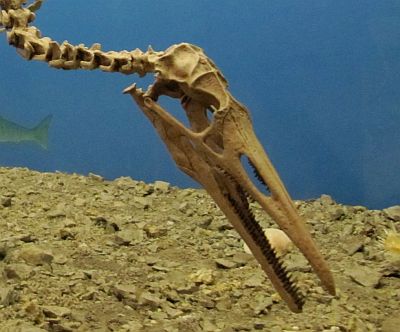
Hesperornis
(Source: Wikipedia)
The point is that toothlessness used to be considered a hallmark of birds. If birds evolved from dinosaurs, then we should be able to find some ancestor of modern birds that does have teeth. Finding ancient birds with teeth shows part of the transition between their ancestors and modern birds.
So, it's true feathers and scales are both made of keratin. Same building block. That's true. But that's where the similarity stops. Okay.
Feather evolution is still a bit of conjecture, but it's not pure guesswork. There are different lines of evidence that evolutionary biologists are pursuing, helping to reveal the story of what happened in the past. Carl Zimmer wrote an article for National Geographic, Feather Evolution, describing some relatively recent research (despite the archaeoraptor controversy described above, National Geographic is still a very good organization). To quote one portion of the article, "In the late 1990s Richard Prum of Yale University and Alan Brush of the University of Connecticut developed the idea that the transition from scales to feathers might have depended on a simple switch in the wiring of the genetic commands inside placodes, causing their cells to grow vertically through the skin rather than horizontally."
Wikipedia has a decent discussion of feather evolution, including the diagram below based on a 2009 paper by Xu and Guo. The big evolutionary innovation was the filament (a possible explanation being that quote from Zimmer's article above). After that, it was a series of small steps to get to modern flight feathers, all of which would have had functions in non-flying animals, that could have later been co-opted for flight in birds.

Proposed Feather Evolutionary Stages
(Source: Wikipedia)
Actually, birds and reptiles have different lung system, different reproductive system, different body covering, different brain, I mean, different circulatory system, thousands of differences exist between dinosaurs and birds. That could be a whole seminar by itself.
Hovind's pulling a bit of a bait and switch here, talking of the differences between birds and reptiles, and then transferring that to birds and dinosaurs. Now, this gets into the problem of classification, but if dinosaurs are going to be called reptiles, they're very derived reptiles, with many 'advanced' traits.
Many of the examples Hovind used are soft anatomy, parts that don't readily fossilize, so it's a bit difficult to know details of those systems in dinosaurs. But what is known points to birds being flying theropods. Perhaps one of the best examples is the first one Hovind mentioned, the respiratory system. Bird lungs are very distinct from mammal lungs. While our lungs operate like a bellows, sucking air in and pushing it back out, air flows through bird lungs in only one direction, making them more efficient at gas transfer. To accomplish this, birds have separate air sacs that do the actual pumping. Evidence in the fossils of theropods indicates that they had a similar type of respiratory system. And it's not just the relatively small maniraptorans. It appears to be a widespread theropod trait, including the well know allosaurus. There are even indications of air sacs in the fossils of early sauropodomorphs, meaning that these air sacs may even have been present in sauropods (i.e. 'long necks' such as brachiosaurus and diplodocus).

Theropod/Bird Respiratory System
(Source: Wikipedia)
It's interesting. There are two different kinds of dinosaurs, the bird hip and the lizard hip dinosaur. Their hips are very different. Ask an evolutionist which type of dinosaur evolved into the bird. Was it the bird hip or the lizard hip? And they will probably kinda hang their head, quietly say, 'Well, it was the lizard hip.' Oh, so now the hip's gotta turn around backwards, too, in addition to all the billions of other changes you've gotta make.
This is no secret at all. There are two main branches of dinosaurs - Saurischia, the lizard hipped dinosaurs, and Ornithischia, the bird hipped dinosaurs. These terms were coined in the late 1880s, when not as many dinosaurs were known as today, and were based on superficial resemblances. The main distinguishing feature is the direction the pubis bone projects from the pelvis. In general, it's forwards in Saurischians, and rearwards in Ornithischians, but there are exceptions. In fact, even in closely realated animals, there can be variation. Below is a picture showing the hips of various Therizinosaurs.

Therizinosauria Hip Variation
(Source: Wikipedia)
It is an odd quirk of fate that the group that was termed lizard hipped is the one that gave rise to birds, and not the one termed bird hipped, but it's little more than an issue of the words used to describe those groups, and not a real reason why birds shouldn't be grouped with the Saurischians. In fact, take a look at these three skeletons. The first is a deinonychus, the second is the archaeopteryx, and the third is a presbyornis, a type of extinct bird, but much more modern in appearance than an archaeopteryx. Pay particular attention to the hips. It's not just the direction the pubis bone projects, but the robustness of that bone, and the overall structure of the pelvis. As with all the other comparisons I've shown, it should be clear which animal archaeopteryx is more similar to. (These images are all copyrighted by Scott Hartman, who has an excellent website, Scott Hartman's Skeletal Drawing.com. He gives permission for non-commercial use of his images, but if you want to copy these, make sure to give Hartman credit.)

Deinonychus
(Source: Scott Hartman's Skeletal Drawing.com)
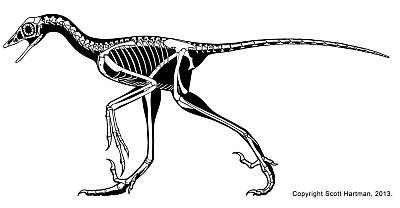
Archaeopteryx
(Source: Scott Hartman's Skeletal Drawing.com)

Presbyornis
(Source: Scott Hartman's Skeletal Drawing.com)
There's no evidence of how dinosaurs evolved through birds. None. Zero.
Well, I would hope that what I've written above is sufficient to put the lie to this claim. And this was all merely a blog entry written by an interested laymen. There are entire books on just archaeopteryx, not to mention the entire subject of bird evolution. There's no lack of information on this subject, and no excuse for someone like Kent Hovind to teach from ignorance.
---
Related Entries (This Site)
- Book Review - Archaeopteryx: The Icon of Evolution
- Is Archaeopteryx Still a Bird?
- Birds Are Dinosaurs
- Book Review - Evolution: What the Fossils Say and Why It Matters (Scroll a little way down for a figure comparing theropod & bird anatomy)
- Creationist Dishonesty and a Follow Up to Previous Entries
Related Links (External Sites)
- Tetrapod Zoology - Clubs, spurs, spikes and claws on the hands of birds (part I)
- Science 2.0 - Farewell, Archaeopteryx
Additional Notes
There were a few more thoughts I had that don't directly tie in to anything Hovind presented, but that might be interesting to some people, so I've included a bit of extra information here.
In case anybody's curious, Saurischia includes the theropods (birds, T. Rex, 'raptors', etc.) and sauropodomorphs (brachiosaurus, diplodocus, appatosaurus, etc.), while Ornithischia includes pretty much all the other types of dinosaurs people are familiar with (triceratops, ankylosaurus, stegosaurus, 'duck-bills', etc.). As far as is known from the fossil record, only the theropods included carnivorous dinosaurs, while every other group was herbivorous. And even some theropods were herbivorous or omnivorous.
When I first learned these groups, I found it intriguing that the four legged sauropods were more closely related to the bipedal theropods than to other four legged dinosaurs. But this was due to the interesting fact of dinosaur evolution that the oldest dinosaurs were bipedal, and the quadrupedality evolved independently in a few later lineages. This ancestry is apparent in many of the early quadrupedal dinosaurs, having great big hind limbs, and short, less robust fore limbs.
I think it's a bit amusing the way creationists deal with transitional animals like archaeopteryx. To creationists, everything has to belong to a certain 'kind'. So, while Kent Hovind was utterly convinced that archaeopteryx was merely a bird, here's another set of creationists arguing that archaeopteryx was clearly a dinosaur, Archaeopteryx Update. But to people who accept evolution and the gradual change this entails, these types of grey areas are expected. Archaeopteryx has a mix of old and new traits because that's how evolution works. It was a type of theropod dinosaur with feathers and wings, most likely not a direct ancestor of modern birds, but very closely related to whatever that animal was.
I know many people are interested in finding direct ancestors in the fossil record, but this is unlikely, not to mention difficult to verify even if someone were lucky enough to find one. I thought of an example that might make this easier for people to understand. Just imagine all the cats alive today - cougars, lions, tigers, jaguars, leopards, house cats, etc. Next, imagine that all of them went extinct except for one species. Now, imagine jumping ahead a few million years into the future, and that you're a future paleontologist living among the descendants of cats, trying to determine their ancestry. And you found fossils of a few of the different types of cats alive today. How would you be able to determine which one was the actual ancestor of your future cats, and which was one of the side branches that went extinct? Really, do you think if you found lions and tigers, that you could definitively distinguish one as the ancestor and one that went extinct? Or, what if you only found lion fossils, but your future cats were all descended from tigers. You may not have found the exact direct ancestor of your future cats, but you would have found an animal very similar to it. That's how it is in paleontology. Archaeopteryx is almost certainly not the direct ancestor of modern birds, but it was alive at the same time, and closely related to, whatever that animal was. We may never find that animal, but archaeopteryx and other fossils we're finding can give us a better idea of what that animal was probably like.
Updated 2017-03-29: Made several tweaks to wording to make things easier to understand, but nothing that changed the overall meaning.
Updated 2018-09-10: Modified the section on Archaeoraptor & feathered dinosaurs - mostly just rearranging to make it read better, not changing any overall meaning.
